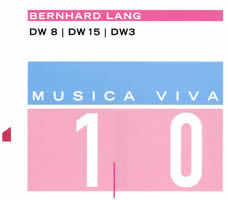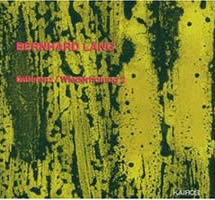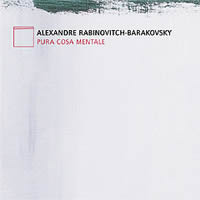Repetition Isn’t Always the Same
|
Grant Chu Covell [August 2005.] Minimalism has long since crawled out of its shoebox. So Percussion just recorded Reich’s seminal Drumming (Cantaloupe CA21026), and it’s a crispy roast, but don’t we listen to classic, square-pattern pieces with different ears than when they back TV documentaries and help to sell cars? Recordings that contextualize are more successful: Rzewski’s process piece, Les Moutons du Panurge, still kicks, especially when surrounded by DJs remixing Rzewski (Stradivarius STR 33631). Bernhard Lang and Alexandre Rabinovitch-Barakovsky have poured the Kool-Aid into plastic cups of different sizes. Both composers work with repetition, toward dissimilar results. They take a phrase, repeat it, discard it, take a new phrase, repeat it, cast it aside, and so on. The pattern is AABBCCDDEE…. Or something or something like this like this. You get you get the idea the idea. This technique has been around for a while. Listen closely to Debussy. Rabinovitch employs neat, even phrases predominantly eight beats long — possibly inspired by Bruckner’s eight-bar subdivisions. Lang’s phrase lengths strive for irregularity, slyly shifting meters. Both composers write for live performers. Rabinovitch’s music is closer to convention; Lang works with jazzers and DJs. Both are happy to use amplification, electronics and synthesizers. Rabinovitch is an accomplished conductor and pianist with top-label recordings of Rachmaninoff, Mozart, Messiaen and Schumann; Lang is comfortable at electronics’ controls. Rabinovitch’s works are subsumed into a gigantic in-progress cycle, “Anthology of Archaic Rituals: In Search of the Center.” Numerology, the I Ching, ancient rites and contemporary religions ferment in his music, oft labeled “musical anthropology.” There’s a slight aura of madness surrounding his oeuvre. Schumann and Scriabin are easy relations with Messiaen’s wild colors as background. When discussing his work, Lang invokes heavy hitters: James Joyce, Gilles Deleuze, William S. Burroughs…. He connects his music with Webern, Cage, Nono and Ligeti. Lang fractures logical or sequential structures, undermining the act of listening. He calls his technique looping — no surprises there — and has derived a compelling technique and theory from practice and performance.
Bernhard LANG: DW 8 (2003); DW 15 (2003); DW 3 (2000). Dieter Kovacic, Marina Rosenfeld (turntables), Symphonieorchester des Bayerischen Rundfunks, Peter Rundel (cond.); Georg Glasl (alto zither), Martina Koppelstetter (voice); Carine Levine (flute), Stefan Hussong (accordion), Michael Moser (cello). col legno WWE 1CD 20090 (http://www.col-legno.de/). Distributed in the US by Qualiton (http://www.qualiton.com/). Vol. 10 in col legno’s musica viva series. Bernhard LANG: Differenz / Wiederholung 2 (1999); The Ovens: Reconstruction (2000). Salome Kammer, Risgar Koshnaw, Todd (vocals), Robert Lepenik (e.-guit.), Dimitrios Polisoidis (e.-violin), Wolfgang Musil (sound projection), Klangforum Wien, Sylvain Cambreling (cond.). Kairos 0012113KAI (http://www.kairos-music.com/). “DW” abbreviates “Differenz / Wiederholung,” or “Difference / Repetition,” which Lang adopts directly from Deleuze’s eponymous book. Distancing himself from most minimalism, Lang eschews tonality. Lift a dissonant bite from Varèse, Webern or Stravinsky, loop it, and you’ll come close. I haven’t picked out any quotes despite suggestive phrases. Youll stop listening for such things rather quickly. Paying attention to other than what’s before one dilutes Lang’s aesthetic. DW 8, for orchestra loops and two turntable soloists, uses passages from Lang’s DW 11.2 for orchestra, performed by Bavarian Radio’s Symphony Orchestra, recorded and pressed to vinyl for the “turntable artists.” It’s a drop-what-you’re-doing listen. En masse the orchestra repeats short, atonal fragments, like a Hercules with Tourette’s. The turntables add sampled orchestra, static, that chipmunk-whine of discs played fast, abrupt cuts and the skipping needle’s familiar sound. The metronome marking is slow, quarter note = 52, and the opening measures are in 6/4 + 1/16. That extra sixteenth note — a mere hiccup — skews the listener’s perception of a constant beat. Score in hand, one sees the music’s periodicity, but the seven-second span stretches the listener’s ability to hear the recycling. Emotionally the music is dreary, with rocking semitones, dissonant floating chords, and gestures attempting to rise above the melancholy. At assorted points a repressed tarantella or mambo-like rhythm endeavors to escape. DW 8 is one of the most revolutionary orchestral works I’ve heard in years. The unusual combination of zither, voice and CD unites for DW 15, ostensibly a song cycle. Martina Koppelstetter’s alto is mellow and buttery, and Lang’s artful vocal contours suggest Boulez’s Marteau or Ravel’s Chansons madécasses. In the outer songs, the CD’s synchronized electronics shadow the zither, producing an illusion of real-time electronic manipulation. The second song uses breathing and hissing for a ghostly atmosphere. Voice and zither play alone in the third of the four, and Lang demonstrates his mid-century avant-garde heritage à la Boulez and Kurtág. Scored for flute, accordion and cello, DW 3 takes its place as the disc’s most conventional work. The trio’s repetitions suggest phrase endings. Sisyphean music: The players can’t complete their gestures without falling back upon duplication. Across seven movements, DW 2 intertwines three incompatible vocal styles: classically trained singer, snooty rapper, and gentle Kurdish folksinger. The instruments include oboe, clarinet, saxophone, two cellos, bass, two keyboards, two percussionists, electric guitar and electric violin. The aggressive repetition, more akin to a DJ’s cutting-up, proves disorienting. Scruffy electronics coupled with coarse vocals expose Lang’s jazz and hardcore chops. Risgar Koshnaw’s mellifluous Kurdish indifferently sidles atop Burroughs’ 1984 parodies (“To speak is to lie; to live is to collaborate …”). Additional words in English and German are plucked from Deleuze and Christian Loidl. One movement is no more than 6:50 of pulsing sine waves with a slight, introductory spoken slogan. More than its series’ cousins mentioned here, DW 2 thrives in a disorganized, apocalyptic space. Bernadette Moser’s three-screen video installation accompanied its first performances. The Kairos disc concludes with a pure tape work, The Ovens: Reconstruction, which loops sampled shreds of DW 2. The pure studio manipulation plummets headlong towards noise. Whatever the samples’ source, the music engages on its own. A two-CD hat set, “<trio x 3>: New Jazz Meeting Baden-Baden 2002” (hatOLOGY 2-607), documents DW 1.2 (2002), various incarnations of Lang’s initial dalliance with repetition involving jazzers (among them Steve Lacy on soprano sax and Paulo Alvares on piano) improvising against duplicated phrases. DW 7 (2002) was mentioned here. Not all Lang’s compositions revolve around repetition. Cellist Michael Moser delivers the abstract cello-solo Schrift 2 (1996) on Durian 007-2. Tapping and scratching, the cellist teases out a pockmarked line.
“Pura Cosa Mentale.” Alexandre RABINOVITCH-BARAKOVSKY: Six Etats Intermédiaires (1998); Musique Populaire (1980); La Triade (1998); Trois Invocations (1995); La Belle Musique No. 4 (1987). Belgrade Philharmonic Orchestra, Alexandre Rabinovitch-Barakovsky (cond.); Martha Argerich, Rabinovitch (pianos); Yayoi Toda (violin), Orchestra di Padova e del Veneto, Rabinovitch (cond.); Filharmonia Quartet (Novosibirsk), Rabinovitch (celesta); Mikhail Adamovitch, Alexei Ieriomine, Anton Batagov, Rabinovitch (pianos). Megadisc MDC 7812/11 (http://www.megadisc.be/). Rabinovitch-Barakovsky sounds like striped candy: bright, colorful, sweet, a quick and easy pleasure but without nutritive value unless you consume huge quantities, which would lead to other problems. Some might be nauseated by the smallest nibble. The opening work on this double Megadisc set, Six Etats Intermédiaires: Sinfonia based on the Tibetan Book of the Dead “Bardo Thödol,” scored for a flamboyant ensemble plumped with synthesizers, provides a gleaming introduction. This Russian émigré adores tonality. Textbook cadential passages with some chromatic passing tones are his meat, potatoes and borscht. Trombones slurp, electric guitars twang, and celesta, pianos and harps tinkle away. About that celesta: Imagine Der Rosenkavalier’s rose-bearer stuck in a mirrored revolving door, or Tchaikovsky’s Nutcracker ballerinas impaled upon music boxes, twirling perpetually. (I suspect Danny Elfman is a closet Rabinovitch fan.) The two-piano Musique Populaire stitches together grand Lisztian gestures that rattle vertiginously, going nowhere. Rabinovitch claims that this piece employs pop-tune modulations, but the finger action suggests 19th-century piano prowess. There may be a connection with Cardew’s populist efforts. Rabinovitch and frequent duo partner Martha Argerich get a workout. La Triade is a sinfonia concertante for amplified violin and chamber orchestra (reissued from Doron DRC 3033). Yoyoi Toda soars over the hyperkinetic chamber orchestra, rather like an LP played at 78 rpm. Giddy with variety, glistening passages could teach Glass and Adams a thing or two. Unfolding a little less repetitively than its companions, Trois Invocations begins with string quartet joined in time by an amplified celesta. The quartet scoring mimics Haydn with a top-heavy first violin and trio backup. This is the most introspective composition among this collection. The celesta could possibly be replaced by a piano for a more traditional quintet ensemble, but that would diminish the work’s shimmer. Odd that the Kronos hasn’t seized this one. La Belle Musique No. 4 is a four-piano monster the storming Rachmaninoff-like gestures of which, along with its ricocheting cadences, remind the listener of a waterfall flowing in reverse. Everybody’s amplified. Impossible not to imagine an energized audience. I pity the piano-tuner’s post-performance chore. Megadisc’s US distributor, Forte Distribution, llc., plans to launch more Rabinovitch later in the year, and Lang is very busy. Watch this space. Composer websites:http://members.chello.at/bernhard.lang/http://www.alexandrerabinovitch.com/
[More Grant Chu Covell]
[More
B Lang, Rabinovitch-Barakovsky]
[Previous Article:
Luigi Dallapiccola: For Orchestra]
[Next Article:
Kipple 2.]
|


